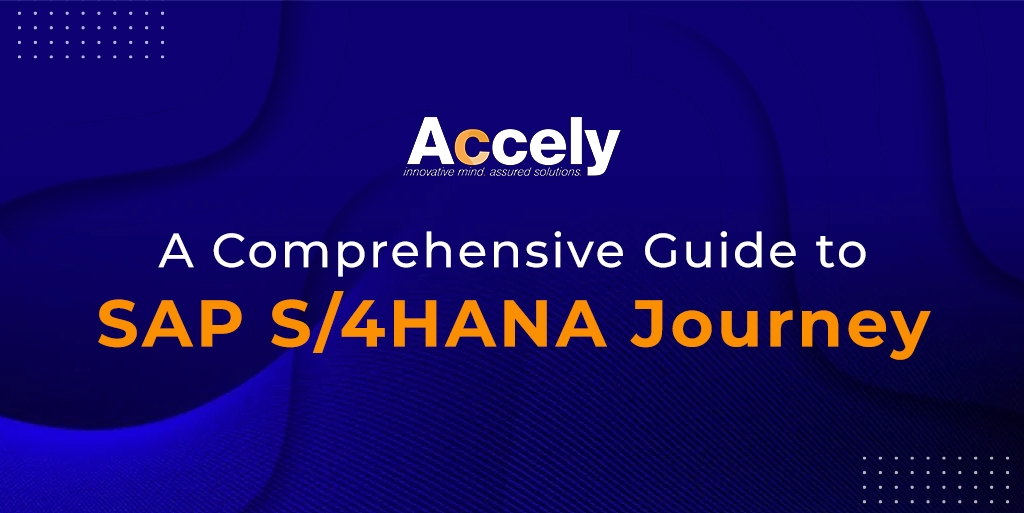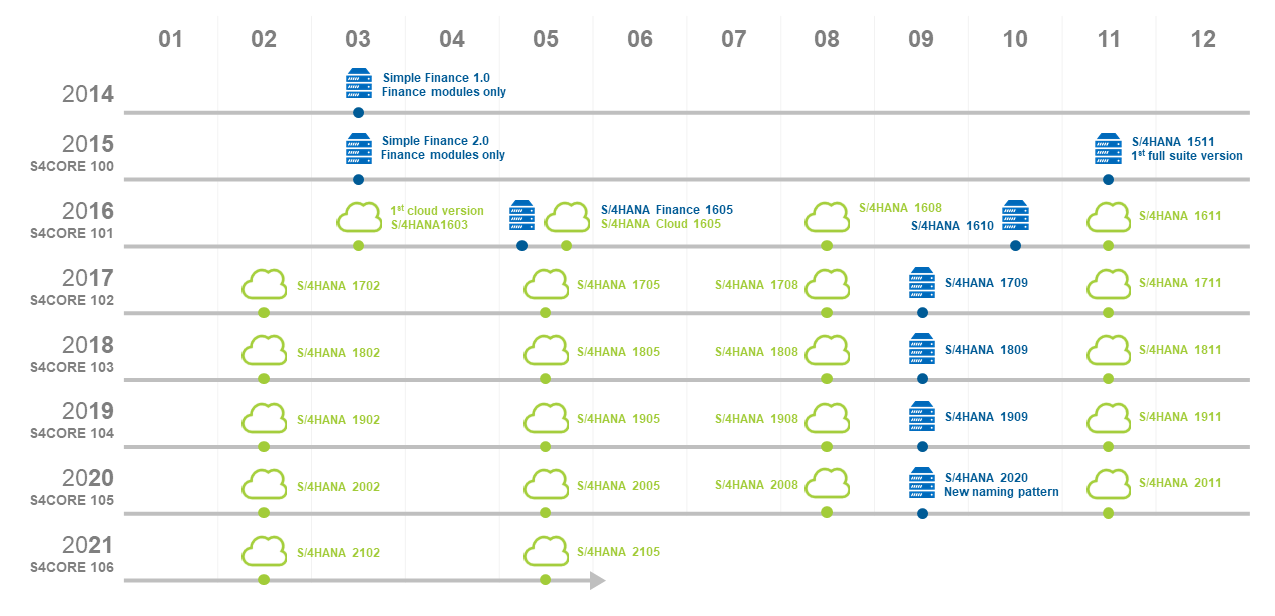A Comprehensive Guide to SAP S/4HANA Journey
19-Jul-2022
Speed, agility, and innovation towards everyday operation are core aspects of the functioning of every successful organization. But, it’s easier said than done! Being an industry head can get challenging. With the growing competitiveness in the digital era, you need to be at the top of your operational efficiency.
However, it’s not that challenging if you’ve been a part of the SAP framework for your existing operations. The latest change in SAP’s strategy can be seen with SAP S/4HANA. It gives enterprises a new “digital core” and is solely intended to function on the SAP HANA in-memory platform.
But making the switch might be intimidating! Even after its successful run, organizations continue to present their doubts over onboarding this new age of ERP. So continue reading as this professional blog assists decision-makers in charting a route for SAP S/4HANA, the company’s latest business suite.
SAP S/4HANA: A New-Age Revolution
A significant change in SAP’s strategy can be seen with SAP S/4HANA. It gives enterprises a new “digital core” and is solely intended to function on the SAP HANA in-memory platform. With its lean architecture, a revamped user experience (based on SAP Fiori UX), and a reduced data model, S/4HANA was engineered with the idea of making ERP quicker, contemporary, and simpler to use.
S/4HANA can analyze data more quickly than prior SAP ERP systems because of the SAP HANA in-memory database architecture and the inclusion of cutting-edge technology. In addition, the platform’s on-premises version can also be set up in a private, public, or hybrid cloud.
Thanks to this new-age solution, companies today can drastically streamline, integrate, and speed up their core operations. In addition, there are several chances to acquire a competitive edge thanks to the increased capabilities of new technologies.
But implementing SAP S/4HANA isn’t only about connecting with an SAP Partner to initiate the migration process. Understanding SAP’s strategy and product roadmap are crucial before starting the migration path.
Continue reading as we map your journey through the SAP S/4HANA migration process.
Challenges to the S/4HANA Migration
Many SAP Architects are getting ready for a transition because SAP will soon stop providing support for its current ERP systems. However, the migration to a new ERP system is not a conventional IT project; it involves a fundamental change. Thus, there are specific difficulties in implementation. LeanIX and PwC performed a survey in 2018 that revealed the main challenges for businesses.
The findings revealed that the most significant hurdles are currently complicated IT landscapes, complex master data, and the ABAP code, which are company specific and incompatible with S/4HANA. Additional worries lead to uneven business procedures that must be unified before relocation.
Additionally, change management lacks the knowledge required to create the ideal plan. Individual parties participating in the coordinating process occasionally slow down the migration process.
SAP S/4HANA: The Different Migration Approaches
The alternatives available to businesses moving their ERP to S/4HANA depend on the extent of the conversion process. For example, the migration process can result from your implementation or your SAP partners’ advice and the cloud infrastructure hosting the ERP.
To sum up the entire migration process, here are the three typical methods that are being followed:
- Greenfield Migration: Greenfield migration presents starting operations from scratch. This process utilizes a brand-new data center or cloud infrastructure and an entirely new ERP system. Although, generally, an organization’s first ERP, this process is also open for existing businesses when they need to transfer from an outdated SAP system or another vendor’s ERP. However, one significant drawback of opting for the Greenfield migration process exists! Organizations opting for this implementation must allocate their time and resources to move the existing business processes to S/4HANA’s methodology. The two other significant obstacles are transferring data from the outdated ERP and educating staff members on the new platform. On the brighter side, the only migration process that allows you to leverage all of S/4HANA’s alleged benefits, including predictive analytics, real-time reporting, AI modeling, and process automation.
- Brownfield Migrating Via S/4HANA Finance: Next up is a migration process that doesn’t require you to undergo operations from scratch. A prevalent option among many businesses, many SAP partners, prefer starting the migration by implementing a financial module, the SAP S/4HANA Finance, and its connection platform, Central Finance. This implementation method is a typical strategy, simplifying the migration and delaying the transition to other modules. Since accounting is a traditional back-end procedure that doesn’t change much, such partial migration is practically possible. Once the front end for a given business module is changed, different aspects of your operations, for instance, logistics, don’t need to be mounted after changing the back end just once. The transition to S/4HANA Finance-Central Finance is an example of a so-called Brownfield strategy, an IT phrase for keeping specific old components in use. It can also be referred to as a hybrid setup to help initiate a smooth transaction.
- Landscape Transformation: Last, we have the Rise with SAP module of the SAP HANA platform. Marketed as “business transformation as a service,” the module is a collection of different goods and services provided by SAP to help clients get their S/4HANA Cloud up and running in real-time. The platform gives organizations access to a broader ecosystem, which (among other things) includes intelligent business process re-engineering and the SAP Ariba procurement network. Businesses can easily leverage processes like SAP public cloud, Google Cloud Platform, or a hyper-scaler like Amazon Web Services. While this implementation method establishes a more direct connection to the cloud, it isn’t a complete migration system. Instead, everything is carried out under a single contract to simplify the administration and coordination of numerous platforms and vendors.
While these were the leading implementation methods, that’s not all! Besides the Rise with SAP approach, consulting companies also have processes and tools for implementing SAP S/4HANA.
They may automate the ERP program code testing to evaluate what can and should be moved to S/4HANA. Additionally, they provide S/4HANA prebuilt setups tailored to particular sectors.
So that’s your overview of the different migration procedures for moving to the SAP infrastructure. Now, to give you a better insight into what you’re signing up for, we’ve discussed some of the prevalent versions of the S/4HANA in the following section.
Different Versions of the SAP S/4HANA
Over the years, S/4HANA has released several modules to complement the functioning of different parts of its ERP environment. While your SAP Partner will assist you with the other versions, it’s always a wise move to understand these versions yourself.
Source: https://blogs.sap.com/
To give you a brief, we’ve discussed some of the versions below. As of 2022, these were some of the S/4HANA releases:
- SAP S/4HANA 1610 – Module launched in October 2016
Following the footsteps of its previous 1511 version, this module of the S/4HANA combines different aspects of the financial data in one system. Besides, in addition to the revised industry solutions, the 1610 version brings you SAP’s version of the EWM (Extended Warehouse Management), simplifying the overall business approach.
- SAP S/4HANA 1709 – Module released in September 2017
The 1709 release of the S/4HANA witnessed better innovations, focusing on on-premise solutions. In addition, this module version brought us the Hana 2.0 in-memory database that ensures new recovery functions, better security, and improved management via the SAP Hana Cockpit.
- SAP S/4HANA 1809 – Module launched in September 2018
Version 1809 of the S/4HANA comes with a streamlined approach to machine learning. The module introduces more such functions, focused on areas such as production, sales, and procurement. Besides, there were also new features like predictive accounting to simplify business finance.
- SAP S/4HANA 1909 – Module released in September 2019
One of the latest releases of the S/4HANA module, the 1909 version, is focused on forecasting, intelligent automation, and best practices inside the industry. However, a primary highlight of this update is its Group Reporting which allows companies to tap into real-time group reporting.
- 2020 – Module released in 2020
The 2020 version of the S/4HANA brings a 360-degree approach to business. The module focuses on innovation and deals with different aspects of finance, with focused improvements on Financial Accounting and Treasury Management. However, Revenue Accounting & Reporting stands out as the highlight of the module.
- SAP S/4HANA 2021 – Module released in 2021
SAPs previously released module in 2021 was focused on Line-of-Business! The module shares updates on quality management and MRP around the Manufacturing area. Besides, the platform also brings new machine learning–based suggestions, enhancing operations in the asset management area.
- SAP S/4HANA 2022 – Module released in 2022
SAPs latest release, the 2022 module, is focused on intelligent enterprises by focusing on the supply chain and its management. The module takes a comprehensive approach to Finance, Manufacturing, and Health & Safety via its innovative features.
Determining Your SAP S/4HANA Migration Approach
The decision to migrate, such as choosing S/4HANA Finance over another brownfield alternative, is often made during the design stage of deployment planning when the strategy and roadmap are established.
When selecting the appropriate migration approach, SAP and its consulting partners provide meticulous strategy and planning procedures. It is sometimes referred to as phase zero and corresponds to the initial phases of SAP’s Activate methodology. The essential phases are as follows, but nomenclature varies:
- Evaluate the current system: This procedure, also known as discovery or readiness assessment, entails evaluating the present ERP system, its data, and the business processes it impacts, frequently using statistics to gauge each component’s effectiveness. Users discuss their problems, and fees for licensing and upkeep are also considered. In addition, IT examines master data and inventories of custom code.
- Review the architecture: In this step, you map your current ERP modules and business processes to the S/4HANA modules and all the available deployment methods while choosing the ones to keep.
- Analyze the future state: Here, based on specifications received from users, department heads, executives, and other stakeholders, you imagine what the new ERP should be able to perform. You also attempt to put a dollar figure on the advantages, such as the cost savings from combining ERP systems or starting a new e-commerce venture. Finally, the data is fed into the business case for the ERP, which is often the following stage.
Once done, you’ll have a better chance of making a reliable migration decision.
Perks of Migrating to the SAP S/4HANA Interface
There is a long list of possible advantages of implementing SAP S/4HANA into your everyday operations! Most of the perks are centered around the SAP HANA in-memory database that underpins the functioning of S/4HANA and speeds up searches and analysis on vast pools of internal and external data.
Besides, the ERP infrastructure also offers other additional benefits like:
- Seamless access to the latest technology, including IoT, AI, & chatbots
- Automatic updates every quarter
- Real-time analytics on consolidated data
- Simplified UI for effortless operations
- Faster period-end financial closings
- Automated operation processing
- Easier-to-update business models
The Question Isn’t About If, It’s About When?
Companies signing up for SAP S/4HANA Cloud will better eliminate competition early on while leveraging new-age innovation. The process will take a lot of time and effort to upgrade current systems to adopt the new business suite’s innovations and keep up. But by doing this, companies will construct on pillars they know will ultimately erode. When they migrate, they must consider any custom code or extensions they create.
By initiating the S/4HANA migration early on, enterprises may avoid the long, expensive project that will interrupt operations that they worry would result from their uncertainty about the SAP S/4HANA deployment process. However, companies may accomplish a seamless, low-risk shift if they are well prepared, practice change management, and access valuable tools and resources.












